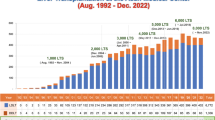Abstract
Background
Few studies have studied the effects of graft quality on non-urgent liver retransplantation (ReLT) outcomes. We aimed to analyze graft characteristics and survival in non-urgent ReLT and the effect of using grafts with extended criteria on survival.
Methods
Eighty non-urgent ReLT were performed from June 1988 to June 2010. The whole series was divided by identical time periods to study time-related effects. We assessed graft quality with donor risk index (DRI) and Briceño scores and recipient status with the Model for End-stage Liver Diseases and Rosen scores. Low and high-risk grafts were defined by a DRI cutoff of 1.8.
Results
Graft survival was similar in both periods (1-, 5-, and 10-year graft survivals: 73.5, 46.9, and 40.8 versus 71, 47.7, and 47.7%, p = 0.935) although donor quality was worse in the second period (DRI: 1.35 ± 0.32 vs. 1.66 ± 0.34, p < 0.001). In the first period high-risk grafts did worse than low-risk grafts (5-year survival: 0 vs. 54.5%, p = 0.002) while in the second period outcomes were similar (5-year survival: 48.6 vs. 56.7 %, p = 0.660). Donor age was the only independent donor factor for graft survival, with lower survival when using grafts from donors over 60-years-old.
Conclusions
Graft quality in ReLT has worsened with time mainly because of older donors but nowadays the use of high-risk grafts in non-urgent ReLT is not associated with worse graft survival because of better perioperative management. Moreover of being selective on recipient conditions, care should be taken when using grafts from donors over 60-years-old for non-urgent ReLT.


Similar content being viewed by others
References
Anonymous (2011) United Network for Organ Sharing Transplantation. www.unos.org/. Accessed 12 June 2011
Memoria de Resultados del Registro Español de Trasplante Hepático (1984–2002). www.ont.es. Accessed 12 June 2011
Markmann JF, Markowitz JS, Yersiz H et al (1997) Long-term survival after retransplantation of the liver. Ann Surg 226:408–418
Lladó L, Castellote J, Figueras J (2005) Is retransplantation an option for recurrent hepatitis C cirrhosis after liver transplantation? J Hepatol 42:468–472
Wall WJ (1997) Recurrent disease after liver transplantation: implications for the future. Liver Transpl Surg 6:362–367
Margarit C (2005) Retrasplante hepático. Med Clin (Barc) 124:733–734
Zimmermann MA, Ghobrial RM (2005) When shouldn’t we retransplant? Liver Transpl 11:S14–S20
Ghobrial RM (2007) Changing faces of liver retransplantation: it is all about selection. Liver Transpl 13:188–189
Feng S, Goodrich NP, Bragg-Gresham JL et al (2006) Characteristics associated with liver graft failure: the concept of a donor risk index. Am J Transpl 6:783–790
Tector AJ, Mangus RS, Chestovich P et al (2006) Use of extended criteria livers decreases wait time for liver transplantation without adversely impacting post transplant survival. Ann Surg 244:439–450
Northup PG, Pruett TL, Kashmer DM et al (2007) Donor factors predicting recipient survival after liver retransplantation: the retransplant donor risk index. Am J Transpl 7:1984–1988
Schmitt TM, Pruett TL, Kashmer D et al (2007) Liver retransplantation for hepatitis C: do extended criteria donors affect outcome? Liver Transpl 13(Suppl 1):443
Martí J, Charco R, Ferrer J et al (2008) Optimization of liver grafts in liver retransplantation: a European single-center experience. Surgery 144:762–769
Wiesner R, Edwards E, Freeman R et al (2003) Model for end-stage liver disease (MELD) and allocation of donor livers. Gastroenterology 124:91–96
Rosen HR, Prieto M, Casanovas-Taltavull T et al (2003) Validation and refinement of survival models for liver retransplantation. Hepatology 38:460–469
Briceño J, Solorzano G, Pera C (2000) A proposal for scoring marginal liver grafts. Transpl Int 13:S249–S252
Amador A, Charco R, Marti J et al (2005) One thousand liver transplants: the Hospital Clinic experience. Transpl Proc 37:3916–3918
Rosen HR, Madden JP, Martin P (1999) A model to predict survival following hepatic retransplantation. Hepatology 29:365–370
Azoulay D, Linhares MM, Huguet E et al (2002) Decision for retransplantation of the liver: an experience- and cost-based analysis. Ann Surg 236:713–721
Conflict of interest
None.
Author information
Authors and Affiliations
Corresponding author
Rights and permissions
About this article
Cite this article
Marti, J., Fuster, J., Navasa, M. et al. Effects of Graft Quality on Non-Urgent Liver Retransplantation Survival: Should We Avoid High-Risk Donors?. World J Surg 36, 2914–2922 (2012). https://doi.org/10.1007/s00268-012-1757-z
Published:
Issue Date:
DOI: https://doi.org/10.1007/s00268-012-1757-z




